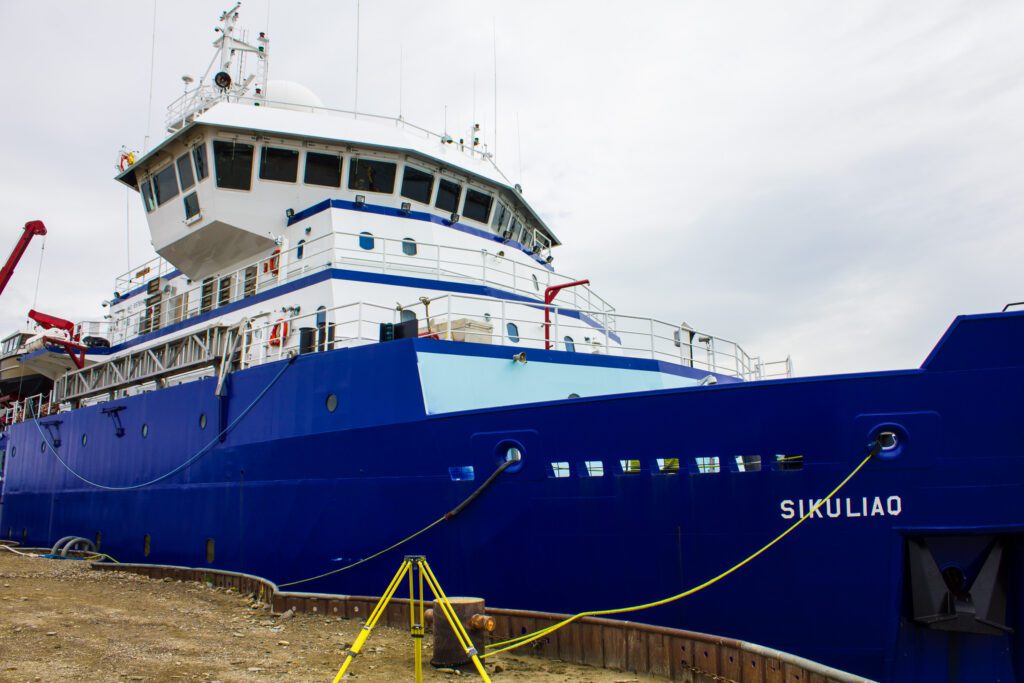A B-25J Mitchell bomber left to rust in Nome after World War II is being stripped for parts—and may one day be refurbished—thanks to efforts from a Michigan war planes museum and help from students across the Bering Strait.
The B-25 was a U.S. military bomber of the same class that went to Russia through the lend-lease program leading up to World War II, and planes of its kind later dropped bombs on Japan after Pearl Harbor. It flew with the U.S. Army Air Force, the British Royal Air Force, and the Soviet Air Force.
In June, Patrick Mihalek with the nonprofit Warbirds Of Glory Museum in Brighton, Michigan, came to Nome to rescue an unusual B-25. “We came up to Nome to recover a World War II B-25 that was sitting out on the tundra for the last 70 years,” Mihalek said, knowing that the distinctly American aircraft had a uniquely Soviet twist.
“We went through the whole wreckage of the aircraft and disassembled it,” Mihalek said. “Many pieces that we need currently for the ongoing restoration we shipped home.”
That “ongoing restoration” is of a different B-25 known as Sandbar Mitchell, another bomber during the war that went on to become a plane for pilots in training, and eventually dumped water on Alaska wildfires near Fairbanks through the 1960s. It crashed in 1969, and after 44 years spent rusting on a Tanana River sandbar, the museum recovered that plane. Mihalek said the museum will use parts of Nome’s B-25 to get Sandbar Mitchell in the air once again.
“We’re going to continue our main project, which is restore Sandbar Mitchell to flying status,” he said. “There’s a few parts from this [Nome B-25] that are airworthy that we’ll put in Sandbar Mitchell, and then vice versa, the parts that are not airworthy from Sandbar Mitchell, because of damage, we’ll put on the Nome [B-25], so in that way, the [Nome plane] could resemble a B-25 once again.”
Just how the B-25 first came to the Seward Peninsula goes back to 1944. After being assembled in Kansas, the bomber was part of a group of planes allocated to Russia through Franklin Roosevelt’s “lend-lease program” prior to and during the U.S. entering World War II. The plane was officially handed over to Russian pilots in Fairbanks, who were set to fly it to Nome and onward to the Russian front. The Nome B-25, however, never crossed the dateline; a rough landing in Nome left it un-flyable, and facilities in Nome at the time left it irreparable.
But the Russian pilots of the Voyenno-Vozdushnye Sily—the Soviet Air Force—didn’t let the plane go to waste.
“The Russians stripped it of all the parts and things they could use as repair parts, or replacement parts, that they felt they could use on their other B-25s,” said museum trustee Todd Trainor during his visit to Nome. “Then it was just left there for vandals and scoundrels to take parts and shoot holes in it with guns.”
In the 1980s, former state House Representative Richard Foster visited Skagway and told then-Skagway resident and aviation enthusiast Mitch Erickson about the bomber. Erickson moved to Nome in 1991, and less than a year later, he found the B-25: axed, chopped, and shot up over years of impromptu target practice. He got the plane loaded on a flatbed and hauled away for safekeeping, but one wing still bearing the red star of Soviet Russia remained trapped in the mud.
“We actually had the NACTEC kids there when we pulled the old wing out of the mud,” said Nathan Pitt, the program coordinator for NACTEC, the Northwestern Alaska Career and Technical Center in Nome. “We had to have every hand available to flip that old wing over. And there on the other side you could see the Russian star still on there, barely visible, but it was still there.”
Recovering Nome’s B-25 was built in to NACTEC’s summer aviation program, and students from Nome and across the Bering Strait worked to recover the plane and disassemble its components.
Pitt said it was an application of the skills students learned working on NACTEC’s own ongoing restoration of another plane, a 1962 Piper Colt. The coordination linked the historic plane to their work in the classroom.
“The 1962 Piper Colt is NACTEC’s project that we’re restoring, so the kids were putting rivets in and also taking rivets out [of the Piper Colt], and then they went over to see the B-25 project, where they were taking all the rivets out in order to disassemble the plane,” Pitt said of the multi-day project.
“They could see where this work was done, and they had a little bit of knowledge about the process and the parts that, you know, keep a plane together.”
The Nome bomber now sits in a shipping container within Nome’s Satellite Field T-hangar—itself a relic from World War II—not far from where the wing was dragged from the mud. “Hopefully within the next year, we’ll be able to raise some money to have the shipping container shipped back to Michigan,” Mihalek said.
The ultimate goal would be to get the Nome bomber flying again, but the wing’s spars are corroded and a “substantial donation” would be needed to make that happen. Failing that, Mihalek said it could be assembled as a static airplane, offering a distinctly Russian display piece for the Michigan museum to tell the unique story of the B-25.







